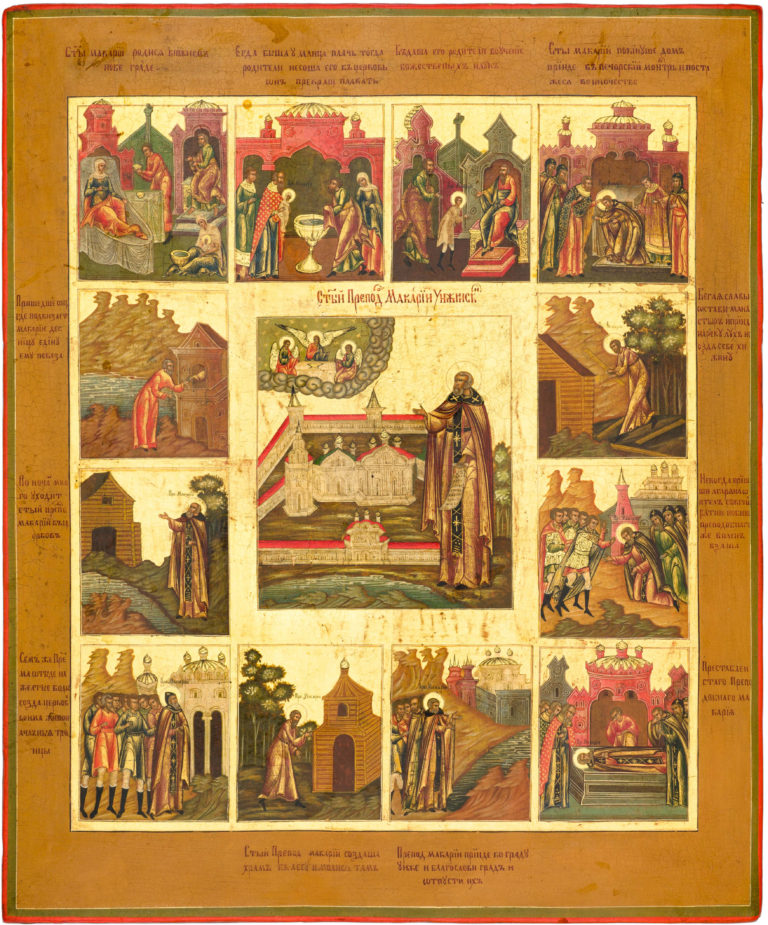Saint Macarius of Unzha (Zheltovodsky), with 12 Hagiographical Border Scenes
Antique Russian icon. Middle – third quarter of the 19th century. Central Russia.
Size: 45 х 37 х 2.2 cm
Wood (two panels), two incut support boards (now lost), absence of the incut centerpiece, underlying layer of canvas is not visible, gesso, tempera, gold.
The author’s paintwork is in very good condition with only small fallouts of paint on the borders of the religious icon.
Contact us

Saint Macarius of Unzha (Zheltovodsky), with 12 Hagiographical Border Scenes
Diagram of the border scenes:
- The Nativity of Saint Macarius;
- Parents bring their weeping baby into the Church;
- The Education of Saint Macarius;
- Saint Macarius is tonsured a monk in the Pechersk monastery in Nizhniy Novgorod;
- Macarius’s Father comes to the monastery, but the Saint would not meet with him;
- Fleeing from fame, Saint Macarius goes to the river Lukh, where he builds a hut for himself;
- The Prayer of Saint Macarius in the Church;
- The Tatars sack the monastery and take Saint Macarius prisoner;
- The Foundation of the Holy Trinity Monastery in Zheltovodsk;
- Saint Macarius builds a church in the forest and prays there;
- Saint Macarius comes to Unzha;
- The Dormition of Saint Macarius.
The given piece of hand-painted Orthodox icons of saints depicts Saint Macarius (1349-1444), one of the most venerated Russian saints and wonder-workers, the founder of a series of monasteries in the Nizhniy Novgorod region, a great ascetic known for his work among the Cheremis, Chuvash, and Tatar peoples. Macarius was born in 1349 in Nizhniy Novgorod in a pious family. When he was 19, he secretly left his home and was tonsured a monk in the Pechersk Ascension monastery. He proved himself to be a strict ascetic, winning the approval and respect of other monks.
Leaving the Pechersk convent, Macarius went to the river Lukh where he soon founded the Theophany (Bogoyavlenskii) monastery. Then he left for a small place known as Zheltye Vody where he built a small cell and, in 1434, founded the Holy Trinity Monastery (later known as the Troitsky—Zheltovodsky monastery). In 1439, the monastery was sacked by the Kazan Tatars who killed most of the monks and took Macarius prisoner. The Saint was freed only after giving a promise not to restore the monastery in its original place. After this, Macarius went up the river Unzha and founded a new convent also consecrated in honor of the Holy Trinity (the Macariev Unzhenskii monastery). Here Macarius fell asleep in the Lord in 1444, being 95 years of age. Before being canonized by the Patriarch Filaret of Moscow in 1619, the saint was venerated locally in the regions of Nizhniy Novgorod, Galich, and Kostroma. His holy relics were retrieved in 1671 during the building of the dedicated to him stone church in the Unzha monastery. Saint Macarius’s feast is celebrated on August 7th and February 5th as part of the Sobor of the Kostroma Saints.
Hand-painted Orthodox icons of Saint Macarius became widespread in the 17th century, following his canonization. The saint’s icons traditionally depict him in monastic garments before the monastery on the Volga River, with the hood dropped on his shoulders and the unraveled scroll containing the prayer to the Holy Trinity. The monastery representation in such Saint Macarius Eastern Orthodox Church icons is fairly symbolic, yet the main buildings of the convent are recognizable: the Gate Church of the Archangel Michael (1670), the main cathedral of the Holy Trinity (1658), and the Church of the Dormition of the Mother of God with its bell-tower (1651). The hagiographical border scenes are typical for many antique Russian icons of saints: they contain the main events of the Saint’s Vita, including his birth, tonsure, and canonization, as well as his establishment of monasteries.
Stylistic traits of the given piece of Eastern Orthodox icons of saints – the miniature painting style, subtle and rather dark color pallet, the dryness of the gold hatching – are highly characteristic elements of the traditionalist movement in Russian iconography from the middle to the third quarter of the 19th century, when the saint icon painters followed the Palekh religious icon art tradition but in an extremely simplified fashion.